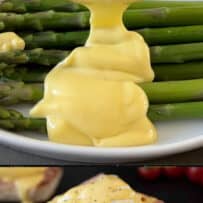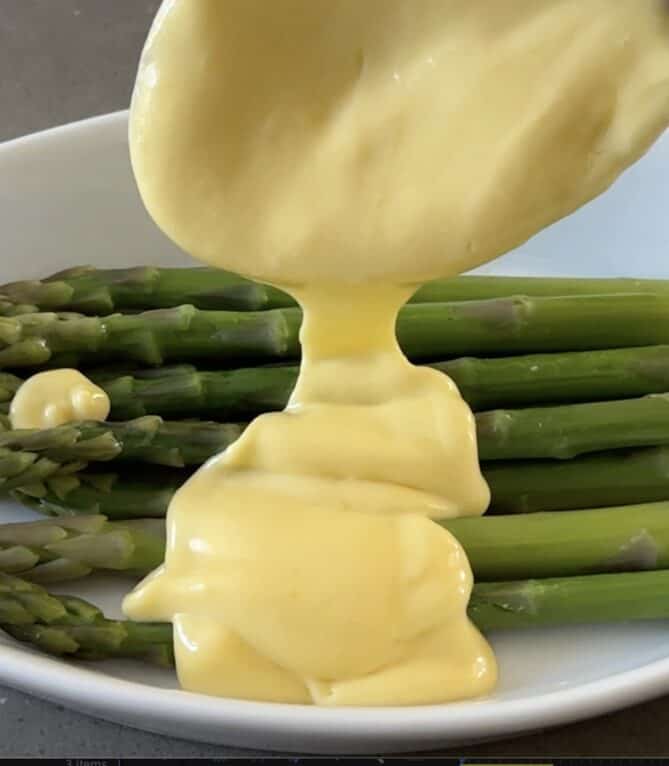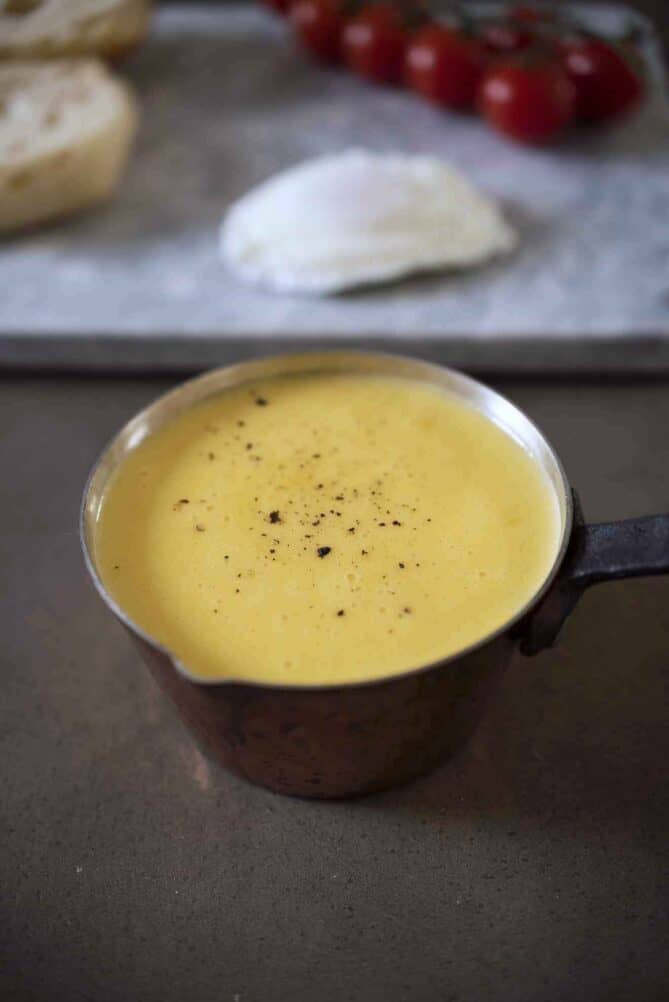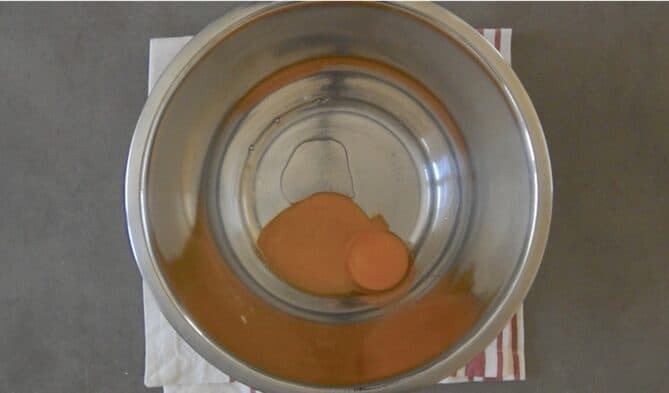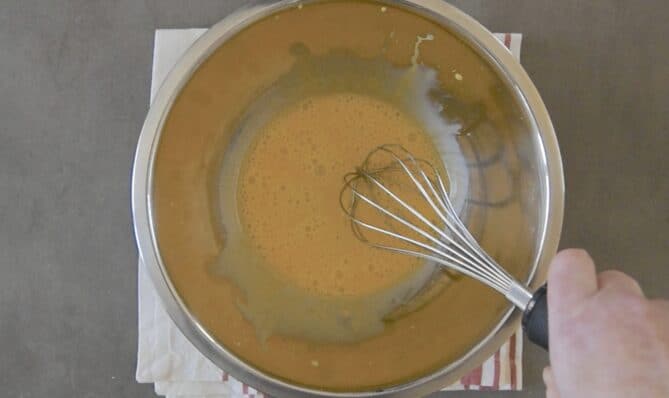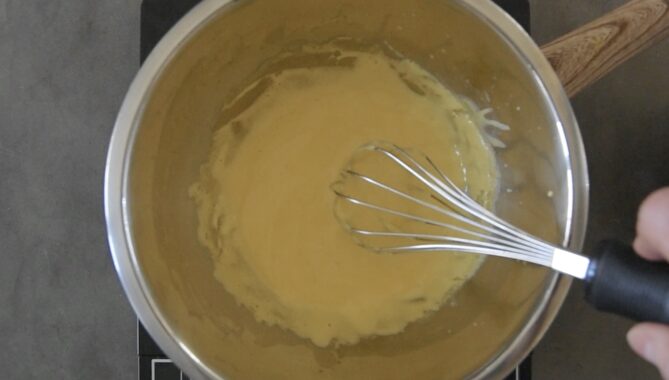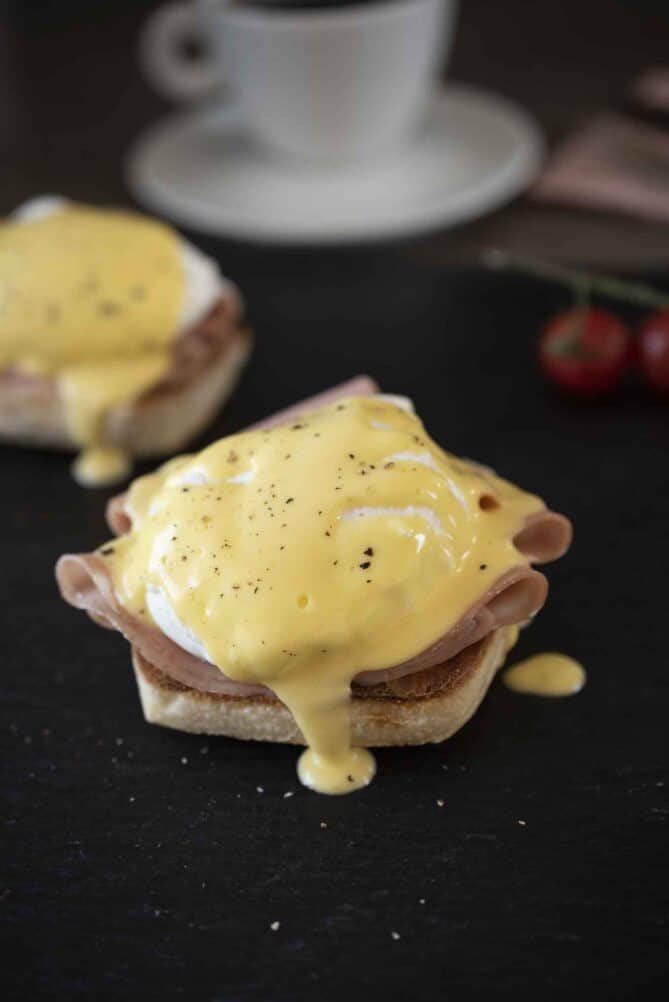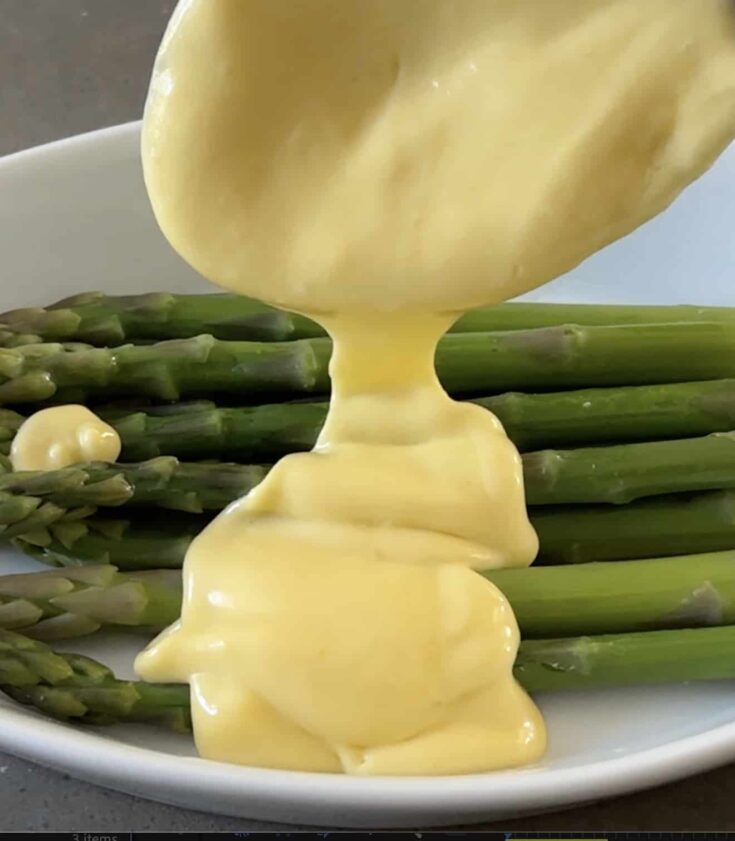Did you know it’s not just for Eggs Benedict? This delicious warm egg and butter emulsion is most often paired with vegetables, meat, fish and egg dishes. Because this sauce can be very finicky when being prepared and can easily split or curdle. But don’t worry, read on… Buckle up, because I’m sharing my tips and tricks that I learned in culinary school so you can get it right, every time. Below, I have the solution to a split/broken sauce, which is a very common occurrence. Hollandaise is one of the five main mother sauces (more on that below). Made with clarified butter and eggs, this warm emulsion sauce is a thick, yet airy, buttery sauce with a hint of lemon.
The 5 mother sauces:
Hollandaise: Popular for eggs Benedict and a base for many sauces like the well known béarnaise (with shallot, tarragon and peppercorns) and choron with added tomato puree. Béchamel: A basic white sauce used to make many cheese sauces. Velouté: A roux (butter and flour) sauce made with a light savory stock. Espagnole: A basic brown sauce made with brown stock, mirepoix (carrots, celery and onion) Sauce Tomate: A basic tomato sauce.
A well-made hollandaise has a rich, buttery flavor with just a hint of acid (typically lemon juice) to balance out the richness of the butter.
The 3 main components of Hollandaise
Egg yolks: They provide the necessary protein and lecithin which helps bind and thicken the sauce. Important tip: the eggs should be as fresh as possible! If not, the lecithin breaks down and weaken the yolks ability to thicken the sauce. Lemon juice: Acid in the form of lemon juice or vinegar is to flavor and balance out the richness of the sauce. I prefer the flavor of lemon juice but vinegar or white wine can be used. Butter: The butter should be unsalted and preferably clarified/ghee. Regular butter can be used, but because of the pure fat content of clarified butter and it not containing any milk solids, it produces a thick and stable sauce. If you do use regular butter, use unsalted so you can control the salt at the end. I have better results with ½ cup (100 grams) of butter per 1 large yolk. To me, this is the best ratio but always have a little more butter on hand in case it is needed.
Equipment needed
A stainless or glass bowl (ceramic bowls will not withstand the heat). Stainless or glass bowls helps keep the temperature of the sauce regulated. You’ll also need a pan that allows the bowl to fit snuggly inside it while still allowing enough room underneath so water does not touch the bottom of the bowl and overcook the sauce. A hand whisk is the final piece of equipment. So now that you know the important players in the game, let’s get to the rules and strategy! There is a lot of information below, but don’t worry, it’s just all the ins and outs of all the aspects of making the sauce. Practice and regulating the temperature while making the sauce then modulating the butter and flavor are the key factors to success. This recipe makes 1½ cups (354 ml) of hollandaise, which should serve 6 people. It starts with a ‘sabayon’, which is simply whisked egg yolks and cold water used to make a light custard dessert.
Hollandaise Sauce step-by-step
First step is whisking the egg yolk and cold water. The water must be cold, as hot will cook the yolks. A stainless bowl is preferred for when you add it to a hot water bath to cook the yolks. If you don’t have stainless, a glass bowl will also work, not ceramic. Once the yolks have tripled in volume, the sabayon is created. To identify if the sabayon has cooked, there are 4 four indicators to looks for before incorporating the butter:
The sabayon should have at least tripled in volume be thick and creamy You should briefly see tracks on the bottom of the bowl as you whisk It should be able to suspend on the whisk without dripping When drizzled from the whisk, it should form a ribbon (you can see this in the video).
You can see the difference from the above image how pale and more voluminous the sabayon gets. I used eggs that have almost orange yolks which create a more yellow sauce. If your egg yolks are very yellow, your sauce will be paler than mine. If undercooked, sabayon will be runny, have an overly eggy flavor and potentially cause the sauce to split. If overcooked, yolks begin to look scrambled or curdle and you will need to start over! Do not add butter to overcooked eggs as they’ve already lost their ability to emulsify the sauce. The bowl is then placed over a simmering water bath to slowly and gently cook the egg yolks. The water must be at a very gentle simmer, not a boil, to avoid cooking too quickly or overcooking. You can remove the bowl if you see them overcooking but try not to splash the mix up the side of the bowl as this will create dried/cooked mix and you don’t want this in the sauce as it will make it lumpy. Then, simply remove the bowl from the pan and continue to whisk off the heat. Next comes the adding of the butter. You will be doing a bit of a balancing act on and off the heat as well as whisking in just the right amount of butter. The key to adding the butter is only add a little at a time. With each addition of butter, as soon as you see the butter disappear into the sauce it’s safe to add more. The consistency you are looking for is thick, but still able to pour off a spoon. Next you whisk in the lemon, just enough to help cut through the richness of the butter, but you don’t want it overly lemon, then salt to taste.
Proper thickness of Hollandaise
I see a lot of sauces that are too thin. I learned a trick from my Culinary Instructors that it should be thick and airy, not runny. A trick is, when you pour it over a brown egg shell it should not run off quickly and if you see the brown-ness of shell through the sauce, it is too thin! It should hold its shape and run just slightly off the shell. You can see this in my video.
Making Hollandaise ahead
You can make the sauce up to 1 hour before you need it. Just keep it warm in the bowl over a pan of very low heated water. Place a piece of plastic wrap right onto the surface of the sauce to prevent a skin forming.
Fixing a broken/split Hollandaise
This can happen to anyone, but depending on the stage, it can be fixed. Before fixing broken or split hollandaise, make sure it is around 125 degrees F by either cooling down or warming over a water bath. To a separate bowl, add 1 teaspoon of cold water or cream to 1 large egg yolk. Slowly whisk this into the broken sauce until the desired consistency is achieved. If it gets thick too quickly, slowly add a little water or lemon juice. In the end, you may not be able to incorporate the broken sauce. If it does not form an emulsion, sorry, you will need to discard it and start again! A repaired sauce will not likely have the same light texture but it can still be used. Even seasoned chefs have had a hollandaise split on them so do not be discouraged if this happens, especially if it’s your first time creating this difficult recipe! Remember, no recipe is foolproof, but I hope I’ve given you all the information and tools you need for making a successful hollandaise. Serving Suggestions This sauce is perfect with Eggs Benedict, or if you would like a twist on this classic sauce, try my Italian Eggs Benedict with Parmesan Sauce and you must know how to How to Poach an Egg so you can whip up this popular brunch dish. You may need less depending on how quickly the sauce thickensTo keep the butter melted and warm, you can keep it over very low heat, or place in a bowl inside a larger bowl of warm water.
